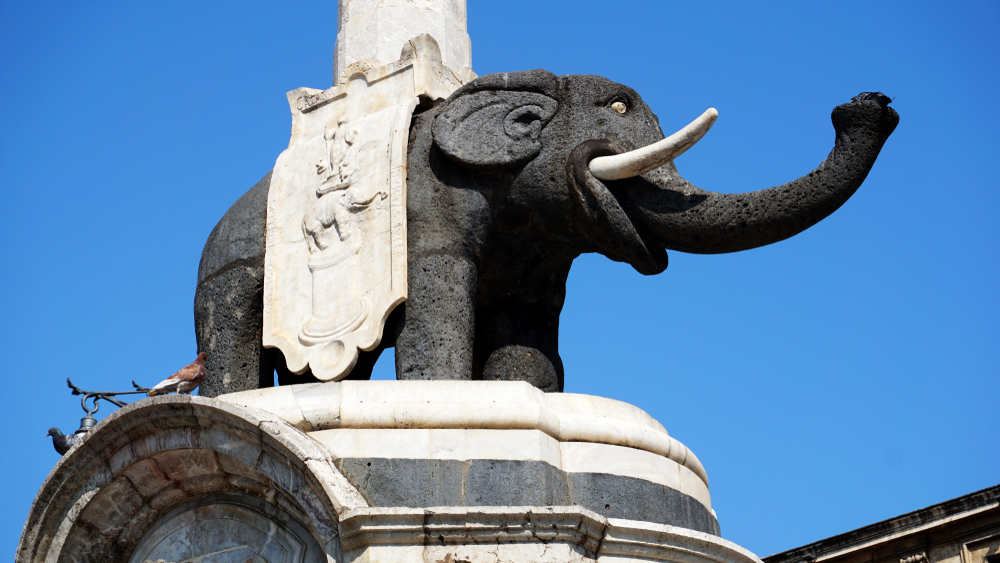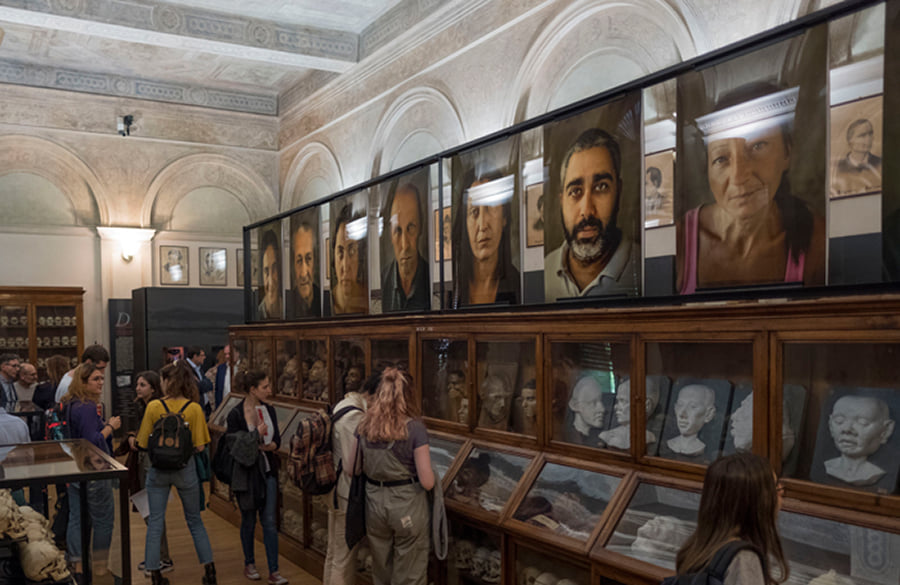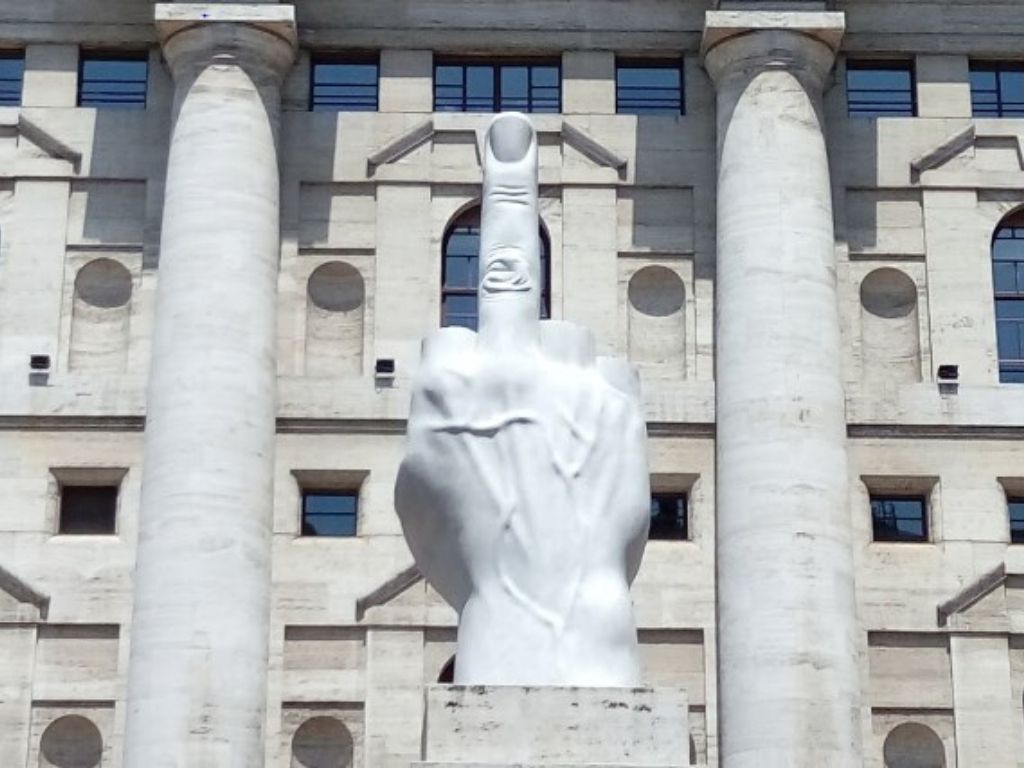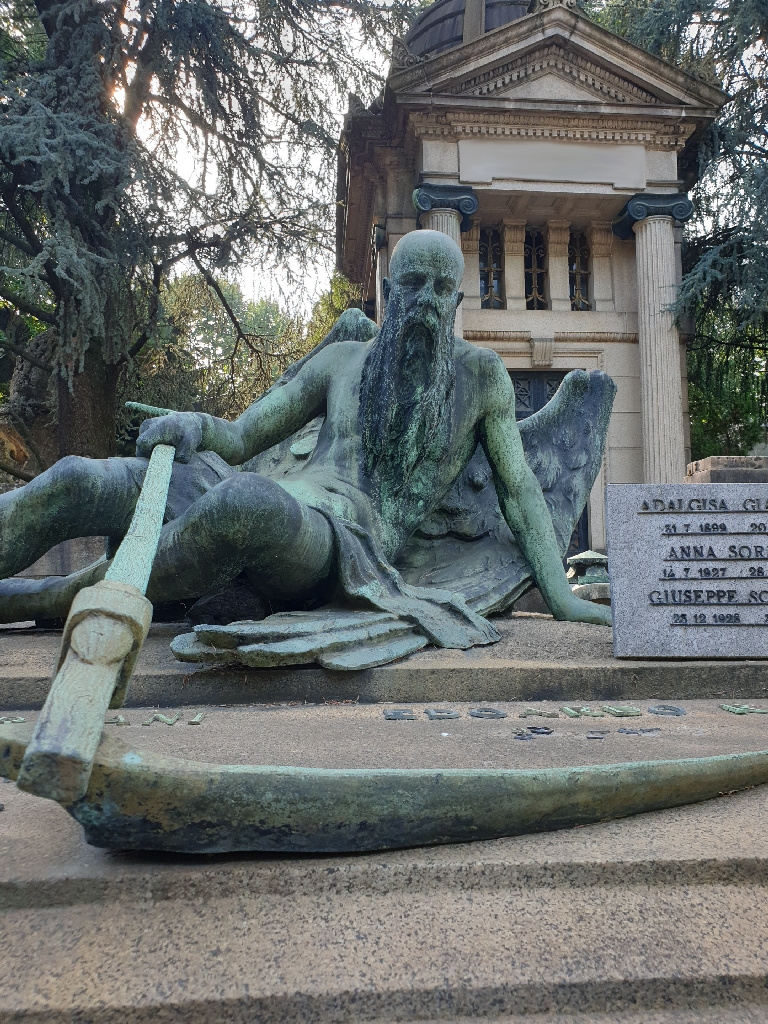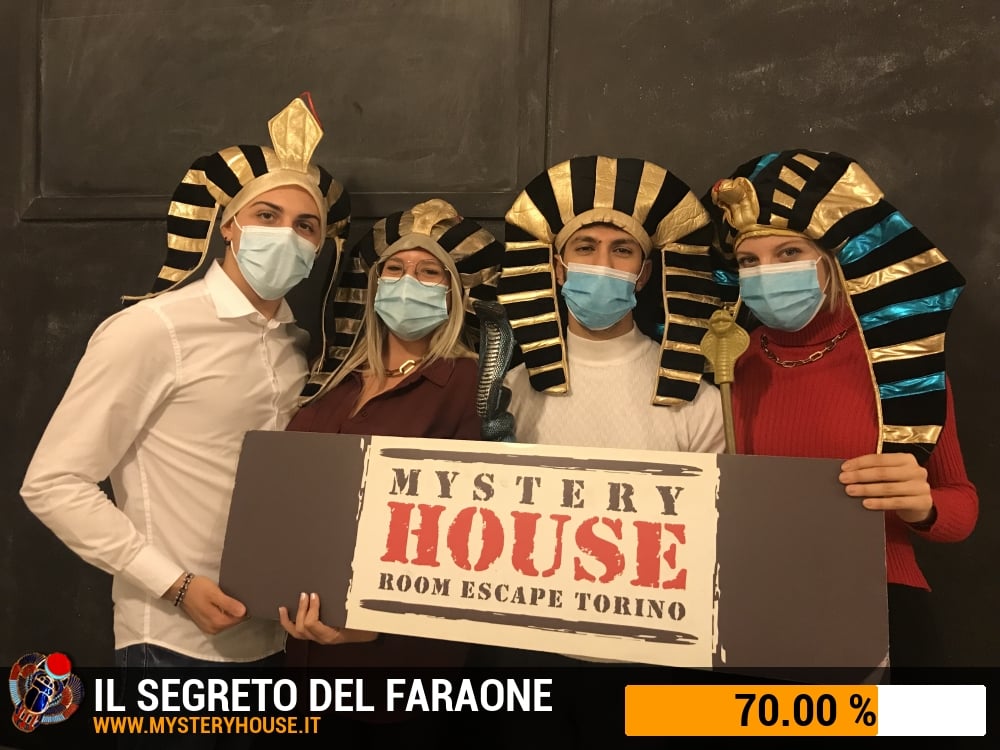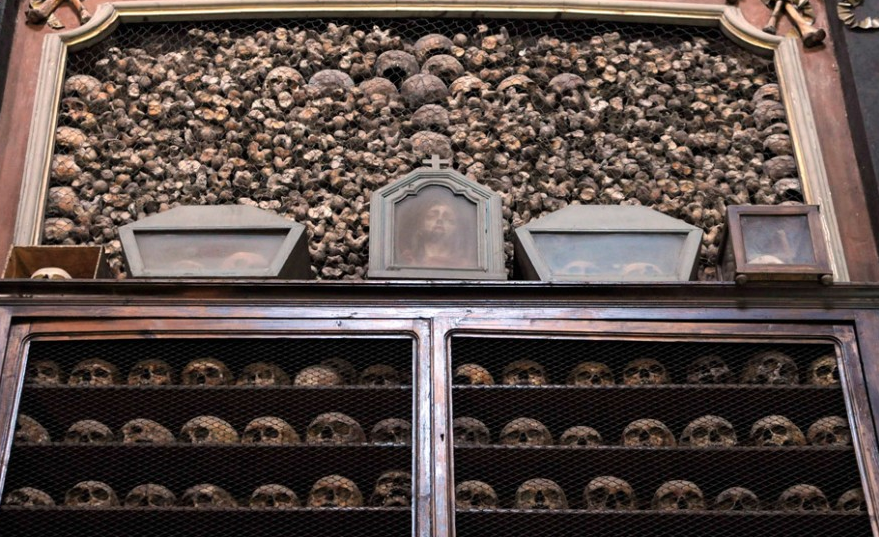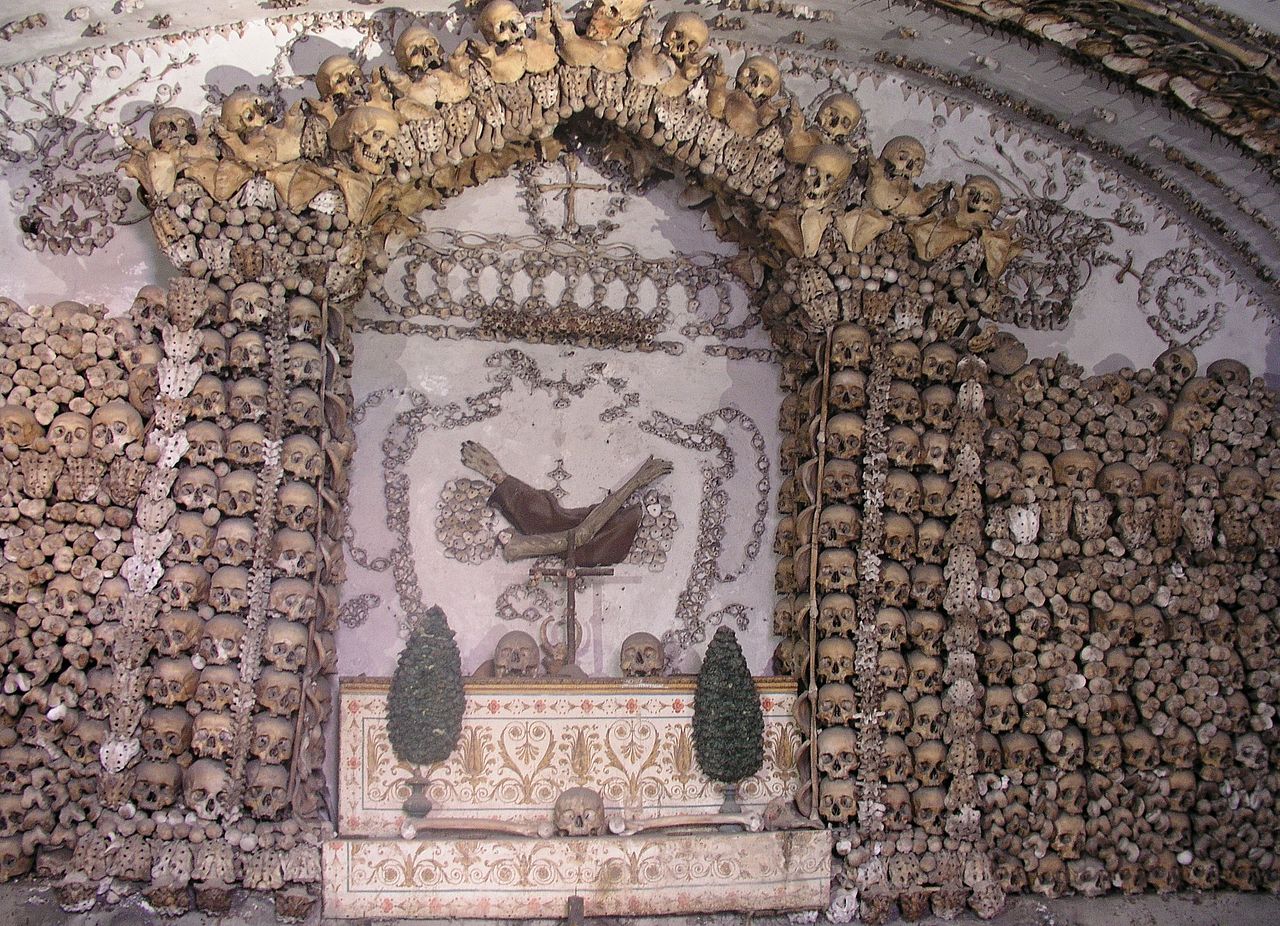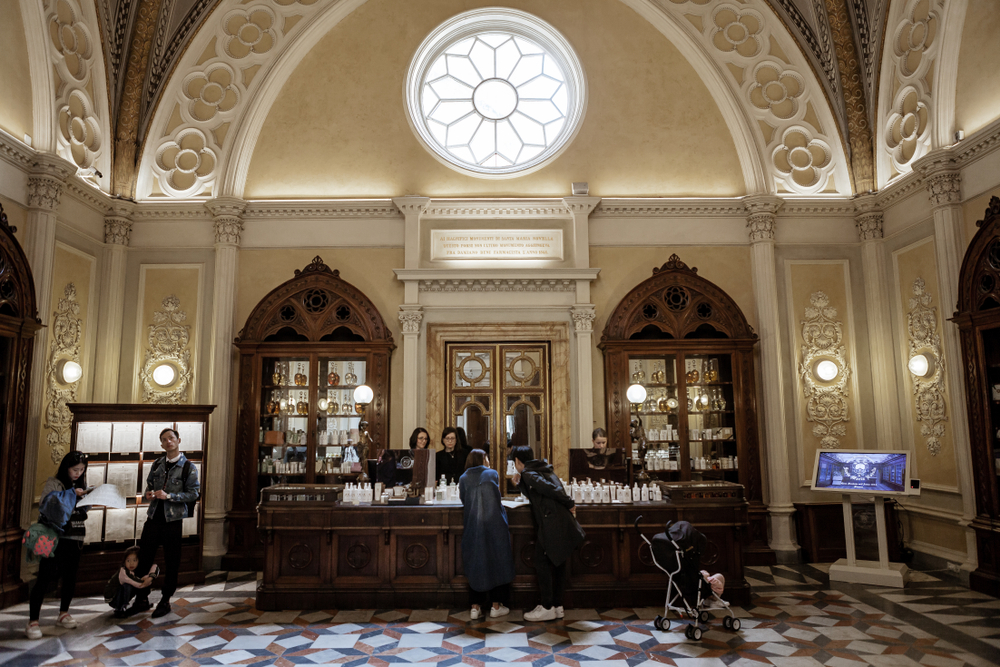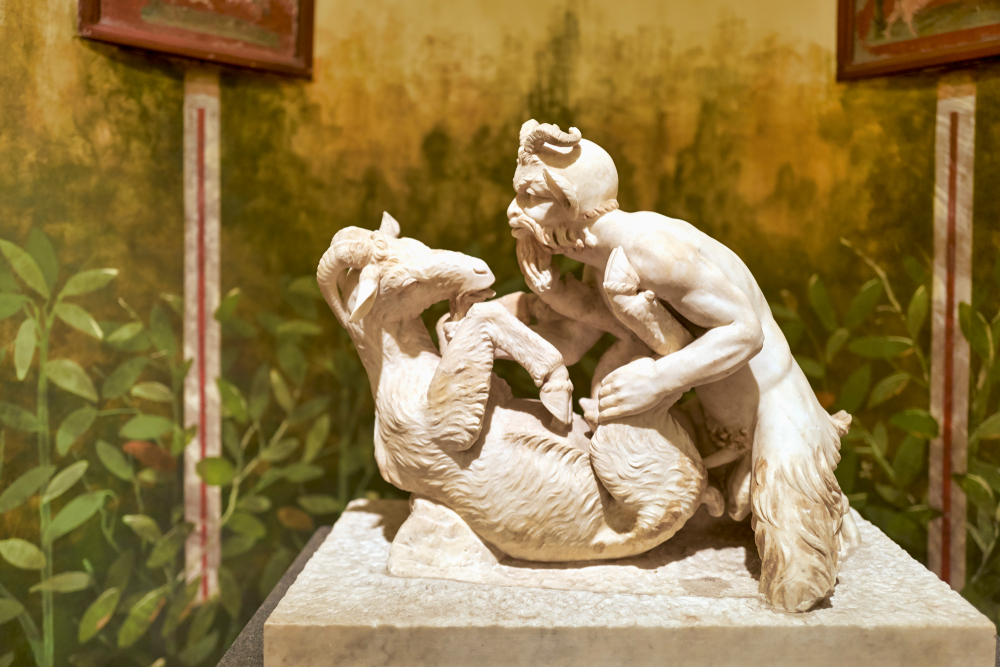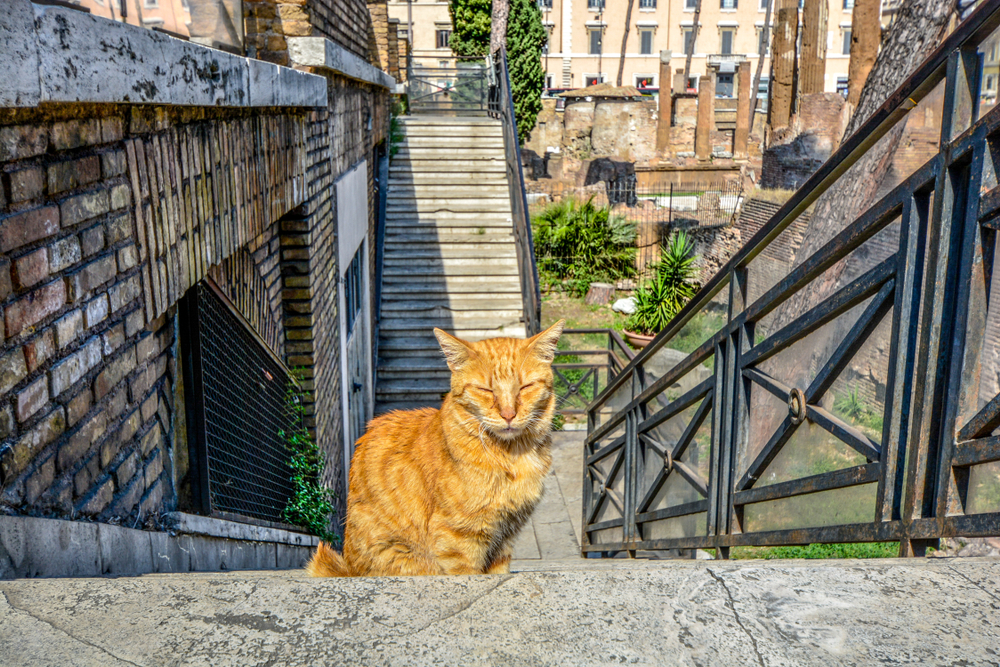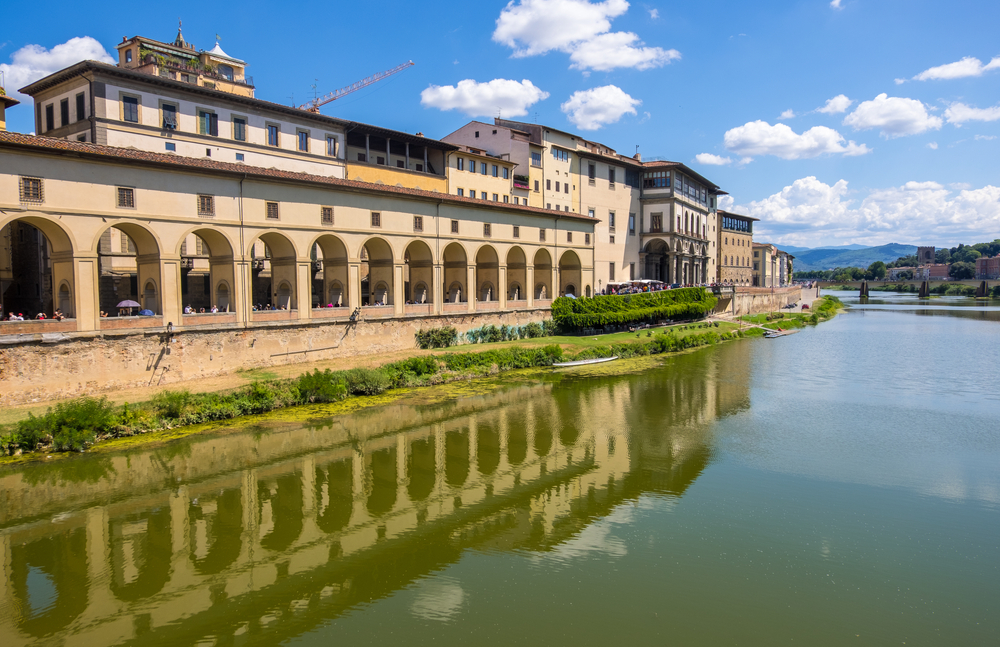Points of Interest
La Berta
39 Via dei Cerretani
Florence, Italy
Within the outer wall of the Church of Santa Maria Maggiore is a stone head named La Berta, that sits among the bricks and begs the question, “Who is that woman and why is she here?” Part of the church wall since medieval times, several stories have emerged over the years. One says the head is a memorial to a market owner who donated bells to the church, which makes sense as the head is within the wall of the bell tower. Another explanation is the head was a remnant of a Roman sculpture repurposed as decoration—a common practice in the Middle Ages. Interestingly, the least likely La Berta legend lives on, with locals claiming the woman was petrified on September 16, 1326, by astrologer Cecco d’Ascoli on the way to his death for heresy. He is said to have cast a spell on her after she shouted out that he should be denied the water he asked for, as he could use the water to communicate with the devil he was in league with.
u Liotru
Elephant Fountain 1 Piazza Duomo
Catania, Italy
Standing atop an 18th-century fountain on Catania’s Piazza del Duomo, u Liotru is an elephant sculpture dating to Roman times carved from volcanic rock. According to written records of mid-12th century geographer Muhammad al-Idrisi, the locals of Catania revered an ancient basalt elephant called u Liotru because it possessed magical powers, including the ability to predict when nearby Mount Etna would erupt. Sicilian architect Giovanni Battista used the elephant as the centerpiece of his fountain, adding a marble saddle bearing an Egyptian obelisk and the coat of arms of St. Agatha, Catania’s patron saint. Today, u Liotru remains the symbol of Catania.
Cesare Lombroso Museum of Criminal Anthropology
15 Via Pietro Giuria
Turin 10126, Italy
Part of the University of Turn, this museum—once only available to academics—showcases the collection of criminologist Cesare Lombroso. Founder of the Italian school of criminology, he tried to link criminal behavior with physical defects of the brain. The museum’s exhibits include brain specimens, hundreds of skulls, dozens of complete skeletons, wax models, criminal evidence, drawings, photographs, and works produced by criminals. Also on display are Turin’s gallows, which were used until the city’s final hanging in 1865. Topping it all off is the head of Lombroso himself, preserved in a glass chamber.
Coppedè Quarter
Quartiere Coppedè Piazza Mincio
Via Tagliamento
Rome 00198, Italy
In the northern part of Rome, Quartiere Coppedè features a mix of many different architectural styles, all by Florentine architect Gino Coppedè who worked on the quarter from 1919 until his death in 1927. Referred to as the city’s architectural fantasy quarter, it includes ancient Greek, Roman Baroque, Mannerism, medieval, and Art Nouveau styles. Used as a setting in a number of films, Quartiere Coppedè has around 40 structures that include a sundial, fountain, mosaics, frescoes, and palazzi. Particularly notable is a music-themed building with exterior ironwork and carvings that imitate musical notation.
Hidden Bomb Shelters
Via Gian Battista Passerini 8
Milan, Italy
Built to provide shelter during the air raids of World War II, a visit to Milan’s underground bomb shelters will have you pondering the events of that major world event. Many of the bomb shelters are being excavated, some located underneath schools and modern buildings where the passages were unknown. A series of gates could seal off portions of the tunnels, protecting occupants from poison gas. Many tunnels include white and white directional arrows used to lead people through the maze of tunnels. Several of the tunnels are under restoration to preserve the pieces of Milan’s—and Italy’s—WWII history.
Houses of Burano
Burano
Venice, Italy
Part of Venice, Burano is a group of four small islands linked together by a series of bridges. It is known for its brightly colored houses, a trend that has been upheld for decades. Repainted every two years, the homes are orange, pink, green, blue, yellow, purple, red, and white, with no two neighbors using the same hue. In fact, residents must first get approval from the local government before painting their houses. The islands can be accessed by taking a ride on a vaporetto, the public water-bus.
Il Porcellino
The Piglet 2R Piazza del Mercato Nuovo
Florence, Italy
Rub the snout of this boar sculpture for good luck, something so many people have done that the bronze statue now has a shiny, golden nose. Though this boar, on display in front of a pharmacy in the Mercato Nuovo, is a replica of the original created in 1634, it is a link to the city’s past. The original Il Porcellino sculpture was created by Pietro Tacca, inspired by a marble boar dating to between 323–331 BCE, itself thought to be a representation of the mythical Calydonian boar from a Greek legend. The original was once on display in the city’s Boboli Gardens though now resides in a museum. The replica boar statue is hollow, and many people drop coins into it through its mouth before rubbing its shiny snout.
L.O.V.E. statue
Il Dito Piazza degli Affari
Milan, Italy
Irreverent images that capture a feeling tend to resonate the most with viewers. This sentiment may explain why a sculpture where Milan’s stock exchange is headquartered is so popular. Entitled L.O.V.E., for Libertà, Odio, Vendetta, Eternità (Freedom, Hate, Vengeance, Eternity), the 11-meter (36-foot) sculpture depicts a hand with only the middle finger raised. Locals call it “Il Dito" (The Finger), and in fact, there are no other fingers curled under, with the others appearing to have been chopped off. The gesture, recognized throughout the world as one most often shown in anger or frustration, was created in marble in 2010 by Italian artist Maurizio Cattelan, known for creating other provocative works of art. Though L.O.V.E. was intended to stay in its location for just a few weeks, the city has kept it there, perhaps indefinitely. It has been speculated that the statue may be an overall statement as to Italy’s—and the world’s—financial crisis that began in 2008, or it is a gesture toward the building it faces, a fascist-era construction built when the dictator Mussolini ruled over the country. Though Cattelan never commented on the sculpture’s meaning, the visitors who detour to the business district—not generally on a tourist’s agenda—to take pictures with it are open to contemplation. Perhaps the statue is flipping the bird to the status that money seems to hold in today’s world.
Libreria Acqua Alta
5176B Calle Lunga
Venice 30122, Italy
With a name meaning “high water bookshop,” Libreria Acqua Alta embraces Venice’s tendency to flood by displaying its books in bathtubs, waterproof bins, and a full-size gondola. Due to the area’s waterways often rising and filling the floor of the shop, its owners had to get creative in order to protect their goods from flood damage. Books, magazines, maps, and other literature are stacked wall-to-wall throughout the shop’s rooms, and there’s even a staircase made of old books. The store also is home to a few stray cats who can be seen lounging among the stacks.
Lingotto
Oval Lingotti Via Nizza 294
Turin, Italy
Originally a car factory, this building is no ordinary one. It was to be the pinnacle of automotive engineering. Designed by naval engineer Giacomo Matte' Trucco in 1921, the five-storied Fiat factory was divided by manufacturing process. So raw materials entered the factory at the base, engine machining took place on the first floor, gear box work on the second floor, and so on until the final story took the roof off, literally. On top of the factory is the Fiat test track, a wondrous oval on which the engineers could see immediately the practical implications of their theoretical designs. Another Italian architect, Renzo Piano, won the commission to redesign the decommissioned factory in the 1990s. His vision was to draw the Lingotto back towards the city, envisioning an exhibition center, hotels, retail space, bars, and restaurants. Don't miss Pinacoteca Giovanni e Marella Agnelli, the Agnelli family's personal art collection, which includes priceless works by the likes of Matisse, Canaletto, Renoir, and Modigliani.
Monumental Cemetery of Milan
Cimitero Monumentale di Milano Piazzale Cimitero Monumentale
Milan, Italy
Though a cemetery may not be the first place you think to visit when seeking art and sculpture, Milan’s Cimitero Monumentale di Milano should be considered nonetheless. The cemetery is one of Milan’s two largest, covering 5,000 square meters (about 53,800 square feet) and is noted for its large amount of artistic tombs and monuments. Included is a large, central mausoleum called the Famedio (Temple of Fame), home to some of Milan’s honored citizens. The Famedio’s beauty includes its architectural style, gothic rose window, and decorative floral and geometric designs. A stroll around the cemetery grounds offers life size sculptures of angels, soldiers, figures representing death, faith, and Greek gods, skulls, flowers, crosses, and more. There is an area dedicated to notable mountaineers and hikers, including a bas relief of a mountain landscape. A quiet and peaceful area shaded by large trees, a stop to the Monumental Cemetery allows for introspection and for pondering the lives of its inhabitants, as well as for admiring the cemetery’s unlikely art.
Museum of Pathological Anatomy
85 Via Giovanni Battista Morgagni
Florence, Italy
Located at the University of Florence, this museum contains wax figures sculpted by 19th century anatomical artists. The wax representations were important teaching tools for the times that were made by artists such as Luigi Calamai, Giuseppe Ricci, and Egisto Tortori. There are tissue samples and plaster casts as well as skeletal remains, many of which are depicted in wax. Perhaps the most famous figure is the leper model from 1851, which turned out to be a man suffering from Norwegian scabies, not leprosy. There also are the remains and model of a child with severe hydrocephaly (abnormal buildup of fluid in the brain, often leading to an unusually large head), among others. The museum is open to the public by appointment only.
Mystery House Escape Room
30 Via Po
10124 Turin, Italy
At Turin’s Mystery House Escape Room groups get 60 minutes to escape uncertain doom. Groups must work together to solve riddles, clues, and puzzles as they try to escape different scenarios. There are several different rooms to choose from including the Egyptian-themed Pharoh’s Secret, espionage-themed The Bomb and The Spy, and Virus, with the goal of recovering an antidote. Another challenge puts two team of two against each other to see who can detonate the bomb first. Instead of being trapped in a room, the 90-minute Urban Escape Game is a type of treasure hunt that takes participants throughout Turin’s city center. In addition, there is an escape room designed just for ages 8 to 13.
Naples Underground
Napoli Sotterranea 68 Piazza San Gaetano
Naples, Italy
Hidden beneath Naples a 450-kilometer (280-mile) network of underground caves and tunnels built in 4th century BC by the Greeks who called it Neapolis, meaning “New City.” Later the Romans would use the pathways to build aqueducts, which provided water for many centuries. The subterranean Italian city is accessed by a long staircase that leads down 40 meters (120 feet) to a maze of caverns, catacombs, aqueducts, sewer tunnels, rainwater cisterns, railway tunnels, roadway passages, and the ruins of a Greco-Roman theater. Used as an air raid shelter during World War II, the site includes forgotten war relics such as weapons and vehicles. Today, Naples Underground also includes an experimental garden.
Pietro Micca Museum
Museo Civico Pietro Micca Via Guicciardini 7a
Turin, Italy
Turin stood alone in 1706, outnumbered by a large Franco-Spanish army and besieged for several months. Although the city's fortifications saw skirmishes daily, the real battle lay underground. Both sides dug deep into the soil, trying either to enter the city or foil those attempts. In one celebrated incident, an Italian sapper named Pietro Micca sniffed out a daring attack by French grenadiers. He blockaded the tunnel, lit a fuse connected to a barrel of gunpowder, scotching the French assault though sacrificing his own life in the process. This unassuming museum is the gateway to more than five miles of tunnels, painstakingly dug out by archaeologists since the 1950s. Visitors can see displays in the museum about the 1706 siege, and arrange tours of the subterranean battlefields. Look out, too, for historical reenactments staged by Torinesi history buffs in period costume.
Platform 16 Holocaust Deportation Memorial
Piazza della Stazione
Florence, Italy
There are two memorials at the Santa Maria Novella train station, one to Florentine Jews and the other to Italians who were deported to concentration camps during World War II. Of the 243 Jews who were sent away, only 13 returned. The station’s largest memorial, located at platform 16, is in their honor. It is a symbolic depiction of a railway track blocked by a large stone block that appears to be split into pieces by a giant metal spike. The station’s other memorial is a modest plaque to 338 Italian men who also were deported to concentration camps, with only 64 returning. Italy became a divided country during WWII, with the south switching sides to defy Nazism and side with the Allied forces, while the north became the Social Republic of Italy under fascist control. The deported men were arrested for questioning, along with women who were later released, by fascist forces looking for information about an earlier strike in their territory that had been called by the National Liberation Committee. The location of these memorials recognizes that the train station was the victims’ place of departure as well as their last sight of Florence.
Sacred Doors Cemetery
Cimitero delle Porte Sante 34 Via delle Porte Sante
Florence, Italy
Cemeteries may not be the first place you think to visit when wishing to view sculptures, yet this Florence cemetery is notable for its funerary art. It also is the final resting place for several famous Florentines including writers and artists, among them the creator of Pinocchio, Carlo Collodi. Located behind the 1,000-year-old church of San Miniato al Monte, the cemetery is reached after ascending to the hilltop location that offers stunning views of Florence. This is just an added bonus, as the sights within the cemetery include larger than life statues of angels, 19th century designs and symbols, allegorical figures, and female figures with gracefully draping clothes that defy their stone origins. Among the many realistic portrayals is the monument to the Mazzone siblings, Mario and Maria, a touching tribute from a mother to her two grown children, whom she wished to remain together eternally. Mario was a fighter pilot killed in World War II, and Maria died a year later, just days before her wedding. The siblings are rendered as full size, smiling statues who face each other, he in uniform and she in a wedding dress. Many of the cemetery’s chapels replicate Florentine churches, having neo-gothic and neo-renaissance designs. Whether you come for the art, history, views, or to recall the contributions of famous Florentines, the experience is sure to leave a lasting impression.
San Bernardino alle Ossa
Via Brolo
Milan, italy
It may prove difficult not to ponder Milan’s history when faced with the skulls and bones kept within the San Bernardino alle Ossa. The church includes an ossuary, a room where the bones of dead people reside. The bones are not kept hidden away in a box but are on full display, arranged in patterns and rows and fronting whole sections of wall as well as doors and pillars. It is believed that most of the bones came from a nearby hospital and its graveyard designated for deceased patients, though space ran out and a small chamber was built in 1210 to house the bones. When the San Bernardino alle Ossa was built in 1269, the bones were moved into a room near the church’s entrance, which also became the final resting place for bones from other graveyards. If you’re not one to be creeped out by rows of skulls and stacks of human bones, then plan a visit to San Bernardino alle Ossa. The centerpiece is a huge cross made of skulls.
Santa Maria della Concezione
27 Via Vittorio Veneto
Rome 00187, Italy
The crypts beneath Rome’s Santa Maria della Concezione dei Cappuccini are the final resting place of more than 4,000 Capuchin friars who died between 1528 and 1870. Known as Capuchin friars because of the capuche meaning “hood” attached to their brown tunic, they moved from the friary of St. Bonaventure in 1631 bringing with them the remains of deceased friars so that all the Capuchin friars could be in one place. The bones were sorted by type with all the skulls, leg bones, and pelvises were used to decorate different crypts along with a plaque that reads, “What you are now, we once were; what we are now, you shall be.” Mummified monks dressed in friar clothes hang from the walls and ceiling. Today, the church also includes a museum.
Santa Maria Novella Pharmacy
Via della Scala 16
Florence, Italy
Florence’s Santa Maria Novella Pharmacy is considered the world’s oldest pharmacy. It dates to 1221, when Dominican monks at the adjacent Basilica of Santa Maria Novella started growing herbs to make natural remedies. These high-quality medicines and balms made the remedies locally known and favored, leading to the pharmacy opening to the public in the 17th century. Today, these original recipes are still followed, along with traditional methods of preparing them. A small museum features antique terracotta jars, though the whole store is outfitted with antiques and is itself a lovely venue worth visiting, featuring vaulted ceilings, frescoes, marble floors, stained-glass windows, bronze statues, and antique scales and mortars. Notable items available include Aceto dei Sette Ladri meaning “Seven Thieves Vinegar,” which are smelling salts so named for a band of seven men who robbed corpses during the plague, dousing themselves in vinegar in hopes of protection as it was believed at the time that bad smells were the cause of sickness.
Secret Cabinet
Gabinetto Segreto National Archaeological Museum of Naples
18/19 Piazza Museo
Naples 80135, Italy
A specific room at the National Archaeological Museum of Naples is reserved for a collection of exotic 1st century Roman art found in Pompeii and Herculaneum. Referred to as Gabinetto Segreto, meaning “secret cabinet,” the room is filled with naked sculptures, sexual depictions, and plenty of penis-shaped objects such as windchimes and oil lamps. There also is an assortment of terra cotta penises, which were thought to bring good luck. Over the years, the collection has been opened and closed repeatedly due to its graphic nature until finally being made permanently available to the public in 2000.
Torre Argentina Cat Sanctuary
1–41 Via di Torre Argentina
Rome 00186, Italy
Largo di Torre Argentina is an archeological site where the ruins of four temples were discovered in 1929. Volunteers care for about 130 cats who moved into the site shortly after it was excavated. Many of the felines suffer from injuries or sicknesses such as being blind or missing legs. A spay and neuter program has been implemented to help keep the area’s feral cat population under control. Visitors can make a donation, volunteer, or even adopt a cat at the site’s underground office where there also is a gift shop with proceeds going toward the cats' care.
Vasari Corridor
Links Palazzo Vecchio to Uffizi Gallery
Piazza della Signoria
Florence, Italy
This aboveground passage dates to 1564 and crosses the Arno River, containing windows that were later added to please Adolf Hitler. Commissioned by Gand Duke Cosimo I de’Medici to enable him to easily move between his home and office, the corridor has some strange angles and turns, necessary in the construction since the path was to be obstructed by a tower owned by the Mannelli family, who refused to alter it or tear it down. The corridor runs along the middle of the stone bridge known as Ponte Vecchio. Connected to the Uffizi Gallery, it features more 1,000 paintings including a collection of self-portraits by artists such as Chagall, Rubens, Rembrandt, and Delacroix, among others. A series of windows in the corridor were added in 1940 at the request of Benito Mussolini to accommodate Hitler, who visited the city and his fellow dictator, both viewing the Arno flowing below the corridor.
Zero-Gravity Trampoline Park
48 Via Carlo Valvassori Peroni
20133 Milan, Italy
Let your children bounce and play at this trampoline park that offers a break from all that history, art, and culture! Sometimes the simplest activities are the best when it comes to keeping kids amused. The whole family can get a little exercise while flipping and having fun, or just watch as your kids laugh and enjoy the free-form play. Some of the trampolines include ramps and there’s a foam pit, ninja warrior area, and dodgeball courts. Rates are charged per hour; check the website for more information including operating hours.
Copyright © 1993—2024 World Trade Press. All rights reserved.

 Italy
Italy 
